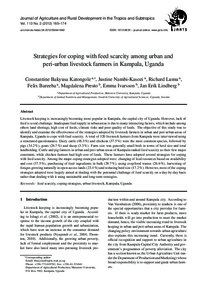| dc.date.accessioned | 2013-03-05T13:30:10Z | |
| dc.date.available | 2013-03-05T13:30:10Z | |
| dc.date.issued | 2012 | |
| dc.identifier.issn | 1612-9830 | |
| dc.identifier.uri | urn:nbn:de:hebis:34-2012092441842 | |
| dc.identifier.uri | http://hdl.handle.net/123456789/2012092441842 | |
| dc.language.iso | eng | |
| dc.publisher | Kassel University Press | ger |
| dc.rights | Urheberrechtlich geschützt | |
| dc.rights.uri | https://rightsstatements.org/page/InC/1.0/ | |
| dc.subject | feed scarcity | eng |
| dc.subject | coping strategies | eng |
| dc.subject | urban livestock | eng |
| dc.subject | Kampala | eng |
| dc.subject | Uganda | eng |
| dc.subject.ddc | 630 | |
| dc.title | Strategies for coping with feed scarcity among urban and peri-urban livestock farmers in Kampala, Uganda | eng |
| dc.type | Aufsatz | |
| dcterms.abstract | Livestock keeping is increasingly becoming more popular in Kampala, the capital city of Uganda. However, lack of feed is a real challenge. Inadequate feed supply in urban areas is due to many interacting factors, which include among others land shortage, high cost of feeds, climate risks and poor quality of feeds. The objective of this study was to identify and examine the effectiveness of the strategies adopted by livestock farmers in urban and peri-urban areas of Kampala, Uganda to cope with feed scarcity. A total of 120 livestock farmers from Kampala were interviewed using a structured questionnaire. Dairy cattle (48.3%) and chickens (37.5%) were the most common species, followed by pigs (34.2%), goats (26.7%) and sheep (3.3%). Farm size was generally small both in terms of herd size and total landholding. Cattle and pig farmers in urban and peri-urban areas of Kampala ranked feed scarcity as their first major constraint, while chicken farmers had high cost of feeds. These farmers have adopted several strategies for coping with feed scarcity. Among the major coping strategies adopted were: changing of feed resources based on availability and cost (37.5%), purchasing of feed ingredients in bulk (29.7%), using crop/food wastes (26.6%), harvesting of forages growing naturally in open access lands (23.4%) and reducing herd size (17.2%). However, most of the coping strategies adopted were largely aimed at dealing with the perennial challenge of feed scarcity on a day-by-day basis rather than dealing with it using sustainable and long-term strategies. | eng |
| dcterms.accessRights | open access | |
| dcterms.bibliographicCitation | In: Journal of Agriculture and Rural Development in the Tropics and Subtropics. Kassel : Kassel University Press. - Vol. 113, No. 2 (2012), S. 165-174 | |
| dcterms.creator | Katongole, Constantine Bakyusa | |
| dcterms.creator | Nambi-Kasozi, Justine | |
| dcterms.creator | Lumu, Richard | |
| dcterms.creator | Bareeba, Felix | |
| dcterms.creator | Presto, Magdalena | |
| dcterms.creator | Ivarsson, Emma | |
| dcterms.creator | Lindberg, Jan Erik | |
| dc.description.everything | Gedruckte Ausg. im Verlag Kassel Univ. Press (www.upress.uni-kassel.de) erschienen. | ger |

